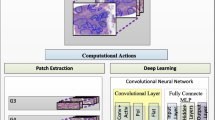Abstract
Introduction
There were more than 1,276,106 new cases of prostate cancer (PC) in 2018 worldwide (GLOBOCAN). Early and precise diagnosis leads to cure chances up to 90%. Digital rectal examination and PSA serum levels are employed for prostate cancer screening. If both exams are suspicious for cancer, the patient will be submitted to a prostate biopsy. Histological diagnosis and grading are crucial to the proper manage of the patients and are not always easy to evaluate, demanding experience of pathologists. To test the possibility to adopt artificial intelligent to diagnose PC, we studied a set of prostate biopsy sample images that were input to a specifically constructed convolutional neural network.
Purpose
Evaluate the potential of the convolutional neural network for the classification of cancer and non-cancer patches extracted from prostate biopsy images.
Methods
Thirty-two prostate cancer biopsy images were obtained and reviewed by a single uropathologist and then transformed into 2594 fragments to feed the CNN. The methodology has been divided into clinical approaches—to extract patches—and computational approaches—the CNN implementation.
Results
The k-fold three-way cross-validation method was used, resulting in a 98.3% output accuracy in distinguishing cancer from non-cancer.
Conclusion
The presented method proved to be robust and trustworthy comparing with an expert pathologist report.







Similar content being viewed by others
References
Arvaniti E, Fricker KS, Moret M, Rupp N, Hermanns T, Fankhauser C, Wey N, Wild PJ, Rüschoff JH, Claassen M. Automated Gleason grading of prostate cancer tissue microarrays via deep learning. Sci Rep 2018;8(1). https://doi.org/10.1038/s41598-018-30535-1
Bell KJ, Del Mar C, Wright G, Dickinson J, Glasziou P. Prevalence of incidental prostate cancer: a systematic review of autopsy studies. Int J Cancer. 2015;137(7):1749–57.
Câncer INd. Estimativa da incidência de câncer no Brasil http://www1.inca.gov.br/inca/Arquivos/estimativa-2018.pdf: INCA; 2018. Accessed August 2020.
Çınar M, Engin M, Engin EZ, Ateşçi YZ (2009) Early prostate cancer diagnosis by using artificial neural networks and support vector machines. Expert Systems with Applications 36 (3):6357-6361
Epstein JI, Allsbrook WC, Amin MB, Egevad LL, Committee IG. The 2005 International Society of Urological Pathology (ISUP) consensus conference on Gleason grading of prostatic carcinoma. Am J Surg Pathol. 2005;29(9):1228–42.
Epstein JI, Egevad L, Amin MB, Delahunt B, Srigley JR, Humphrey PA, et al. The 2014 International Society of Urological Pathology (ISUP) consensus conference on Gleason grading of prostatic carcinoma: definition of grading patterns and proposal for a new grading system. Am J Surg Pathol. 2016;40(2):244–52.
Ferlay J, Soerjomataram I, Dikshit R, Eser S, Mathers C, Rebelo M, et al. Cancer incidence and mortality worldwide: sources, methods and major patterns in GLOBOCAN 2012. Int J Cancer. 2015;136(5):E359–86.
Gleason DF, Mellinger GT. Prediction of prognosis for prostatic adenocarcinoma by combined histological grading and clinical staging. J Urol. 1974;111(1):58–64.
Källén H, Molin J, Heyden A, Lundström C, Åström K. Towards grading Gleason score using generically trained deep convolutional neural networks. 2016 IEEE 13th International Symposium on Biomedical Imaging (ISBI). 2016.
Kasivisvanathan V, Emberton M, Moore CM. MRI-targeted biopsy for prostate-cancer diagnosis. N Engl J Med. 2018;379(6):589–90.
Rouvière O, Puech P, Renard-Penna R, Claudon M, Roy C, Mège-Lechevallier F, et al. Use of prostate systematic and targeted biopsy on the basis of multiparametric MRI in biopsy-naive patients (MRI-FIRST): a prospective, multicentre, paired diagnostic study. Lancet Oncol. 2019;20(1):100–9.
Toro OJd, Atzori M, Otálora S, Andersson M, Eurén K, Hedlund M, et al. Convolutional neural networks for an automatic classification of prostate tissue slides with high-grade Gleason score. 2017.
van der Leest M, Cornel E, Israël B, Hendriks R, Padhani AR, Hoogenboom M, et al. Head-to-head comparison of transrectal ultrasound-guided prostate biopsy versus multiparametric prostate resonance imaging with subsequent magnetic resonance-guided biopsy in biopsy-naïve men with elevated prostate-specific antigen: a large prospective multicenter clinical study. Eur Urol. 2019;75(4):570–8.
Yamamoto Y, Tsuzuki T, Akatsuka J, Ueki M, Morikawa H, Numata Y, et al. Automated acquisition of explainable knowledge from unannotated histopathology images. Nat Commun. 2019;10:5642.
Acknowledgments
Institute of Science and Technology, UNIFESP (ICT-UNIFESP), Coordination for the Improvement of Higher Education Personnel (CAPES), University of Sao Paulo Medical School, Medical investigation laboratory number 55 (LIM-55), Department of Surgery Division of Urology, University Ethics Committee approved the study (approval number 3.004.858).
Author information
Authors and Affiliations
Corresponding author
Ethics declarations
Conflict of interest
The authors declare that they have no conflict of interest.
Additional information
Publisher’s note
Springer Nature remains neutral with regard to jurisdictional claims in published maps and institutional affiliations.
Rights and permissions
About this article
Cite this article
Kudo, M.S., de Souza, V.M.G., de Souza Amaral, G. et al. The potential of convolutional neural network diagnosing prostate cancer. Res. Biomed. Eng. 37, 25–31 (2021). https://doi.org/10.1007/s42600-020-00095-3
Received:
Accepted:
Published:
Issue Date:
DOI: https://doi.org/10.1007/s42600-020-00095-3




